This Dutch Oven No Knead Bread is the perfect way to make a delicious, crusty artisan loaf in the comfort of your own home! Best of all? It takes only FIVE MINUTES of prep, and you don’t have to ever touch the sticky dough with your hands! With a short, two-hour total rise time, you can make this for dinner tonight.
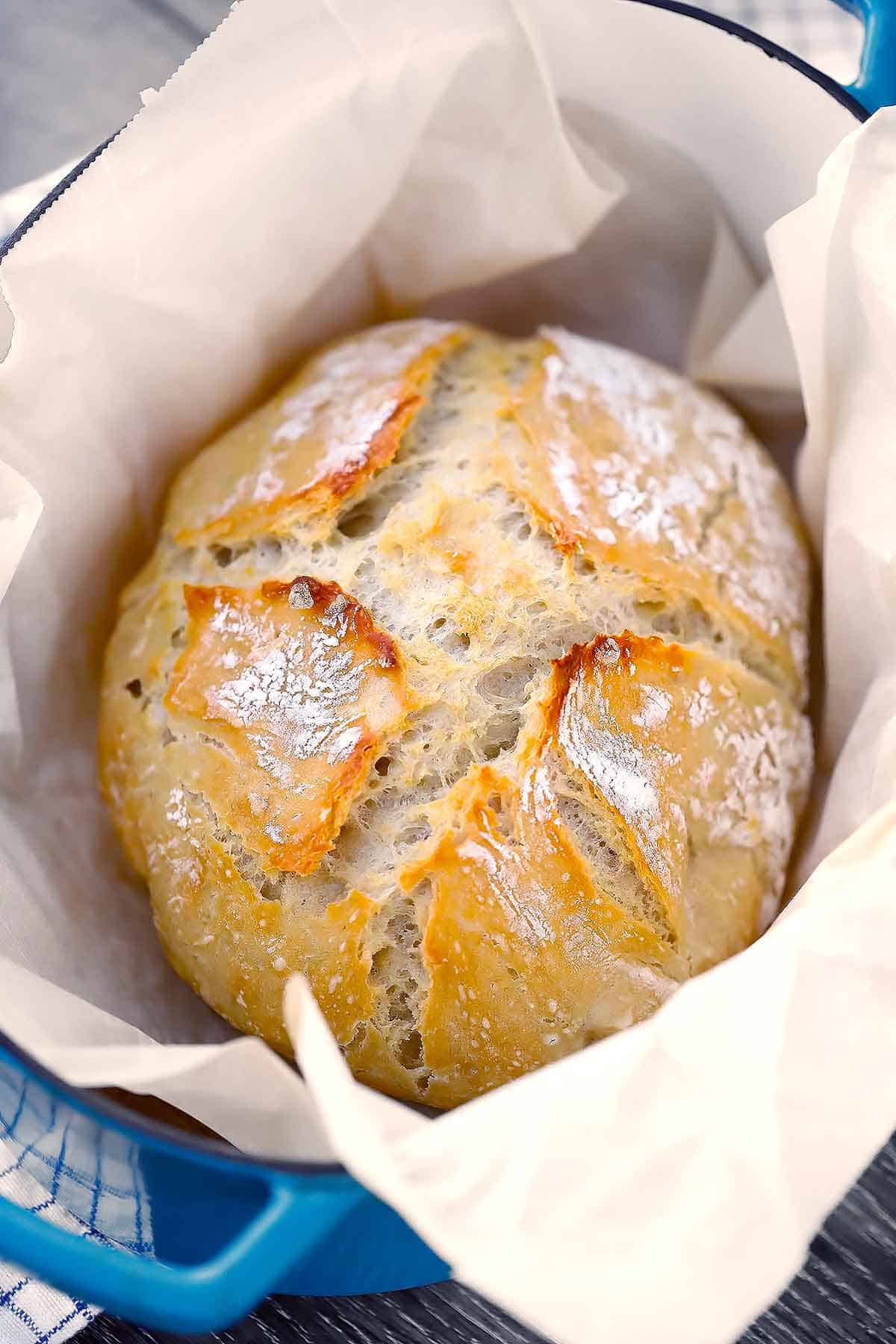
I’m a good cook. I mean, I’m allowed to brag about that… I’ve built a career out of it with this website. But until now, I’ve had the HARDEST time making a good homemade bread.
Am I alone in this? Homemade bread has always eluded me and been a real challenge. My homemade breads have always been too flat, too dry, too hard, too annoying and sticky to work with, etc.
UNTIL NOW.
YOU GUYS. I finally cracked the code for homemade bread that isn’t a hassle and is so amazingly delicious, moist, with fluffy holes, and with the perfect crusty crust!
You can use all-purpose flour – no need for fancy bread flour!
This is the only no knead bread recipe you’ll need, and it’s great for beginner bread bakers. The Dutch oven is key for developing a perfect crusty crust and keeping the inside perfectly moist, and best of all, you don’t EVER have to touch the super sticky dough with your hands!
You can let this dough rise for only 2 hours and bake it right away, OR you can keep the dough in your fridge for up to 7 days and use when you want to. Unlike other no-knead bread recipes that require 12 hours minimum rise time.
Here are all the details.
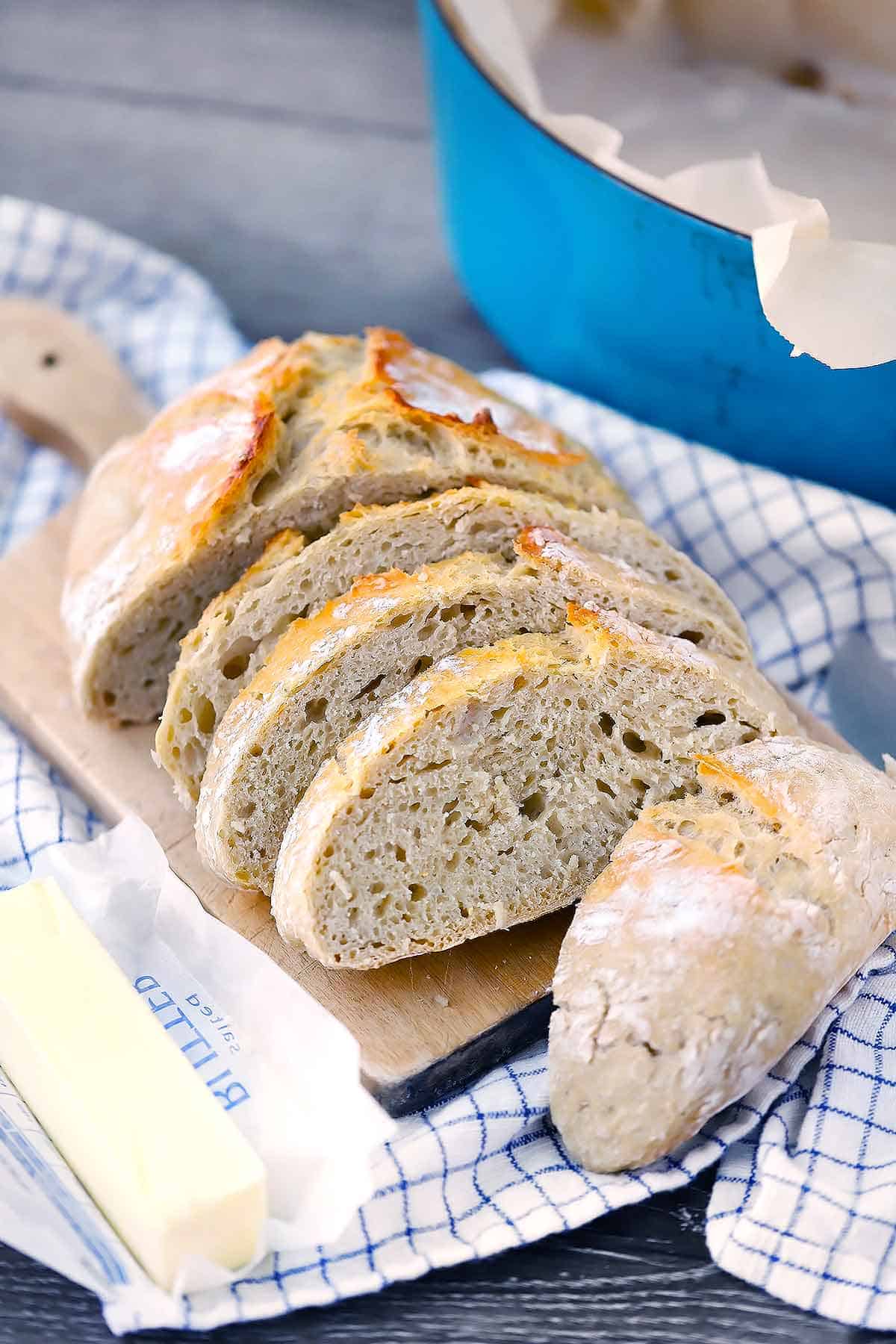
First of all, what is no knead bread?
No knead bread is, as the name suggests, bread that can be made without kneading the dough. No need to knead. Hah!
The dough is notoriously very loose and sticky, which can make it a little frustrating to work with (which is why I developed this method to not touch it at all- it takes a lot of that frustration away!).
No knead bread loafs do not need a second rise time, like a traditional loaf. The bread doesn’t have enough structure to rise “up,” and instead will flatten out and fill the shape of whatever you are making (Note: you CAN do a second rise time with no knead focaccia, which is a flatter bread type.)
The lack of a second rise results in two things: first, a faster overall time to make. And the second: it won’t have as many holes as a kneaded bread dough.
While I love a good fluffy artisan bread with holes for days, I think the pros here outweigh the cons. The bread DOES have some good holes, it’s got a great texture, and the fact that it’s so easy and hassle free is enough to make me never want to make a kneaded artisan loaf again!
How to make no knead dough
You only need water, yeast, flour, and salt for this no knead bread dough.
- First, warm the water (1.5 cups) to about 100 degrees F. A little more or less is fine. I usually measure it in my pyrex measuring cup and put it in the microwave for about 40 seconds, then take the temperature with a meat thermometer to make sure it’s the right temp. Don’t go any hotter than 110 degrees F – it might kill the yeast.
- Then, add the warm water to a large bowl, along with a packet of yeast, or 2.25 teaspoons (instant or active dry is fine) and 1/2 tablespoon of table salt (or 2 teaspoons kosher salt). Whisk together until the yeast and salt are dissolved.
- Finally, add the flour – 3.25 cups – all at once, and stir with a wooden spoon until everything is uniformly wet.
I like to use a silicone spatula to scrape the dough off the wooden spoon, as it will be quite sticky and loose.
Letting the dough rise
Once the dough is mixed, just cover it with a kitchen towel and let it rise in a warm-ish spot for two or three hours. It should double in size at least.
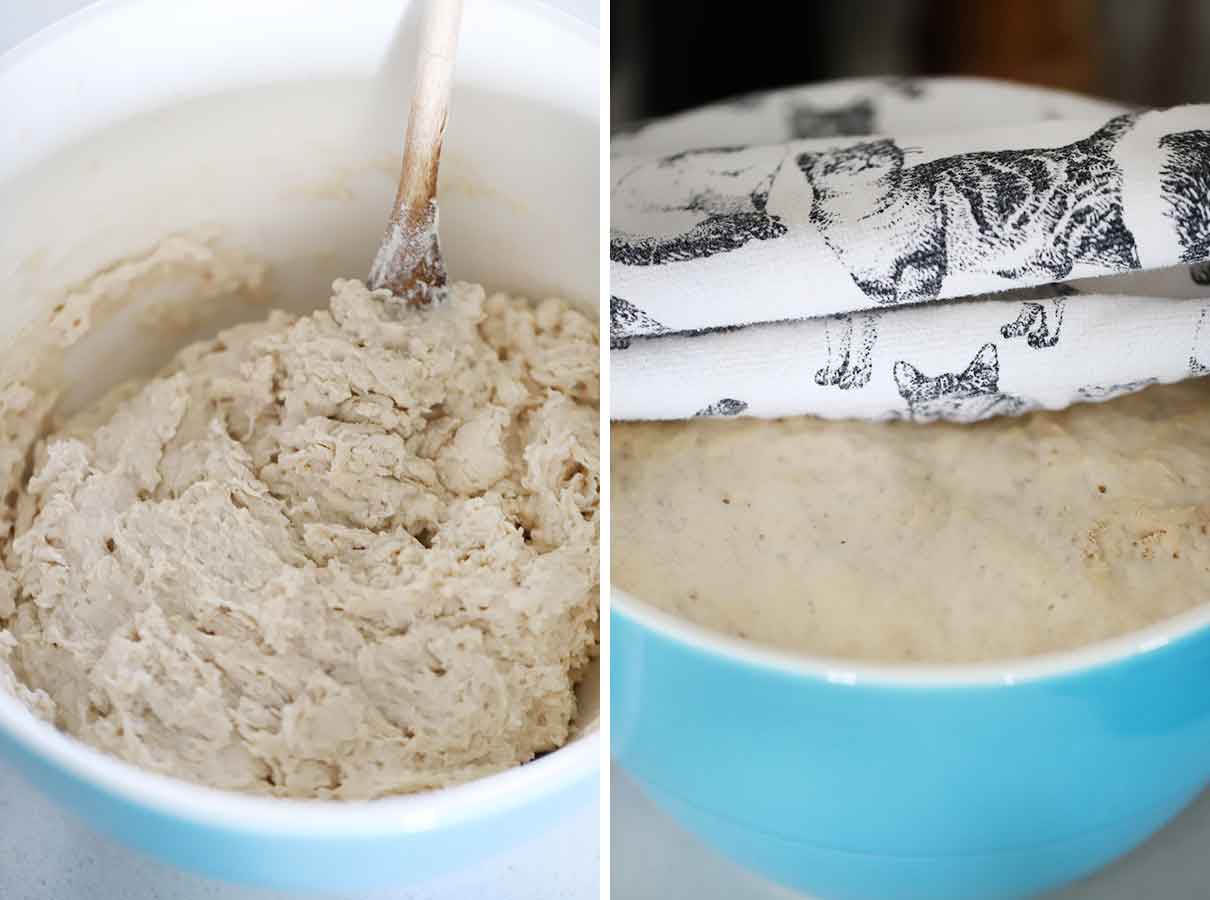
If your house is cold, I recommend turning your oven on for a few seconds, turning it off, and placing the bowl in the warm oven with the door closed to trap the heat in.
If you’re using your oven to cook something (or in the next step when you need to preheat your Dutch oven), you can leave the bowl on top of the stove- the vented heat at the top will help it rise well.
You can also get some really hot water in a mug or glass measuring cup, stick it in the microwave, and place the bowl next to it. Shut the door to the microwave- this will trap the warmth and steam inside.
If your house is warm, you can just leave it out.
If it’s warm outside, you can leave the bowl outside.
Storing the dough in your fridge
After the dough has risen for 2 hours, you can bake it immediately. But if you like, you can stick it in your refrigerator for up to 7 days until you’re ready to bake it!
Cold dough is a little easier to handle, so that’s a pro for this.
I recommend using plastic wrap or something more airtight to cover the bowl when you put it in the fridge. If you know you are making this dough days in advance, you can mix it up in a container, keep the lid on ajar while it’s rising and then seal the lid when you put it in the fridge.
The taste will get funkier as time goes on- by the 7th day, the bread will taste more like sourdough. And the dough will collapse over time- don’t worry about this.
Preheating the Dutch Oven
You want your Dutch oven to be good and hot for baking the bread so it gets a chance to crisp up properly on the outside.
About 30 minutes to an hour before you want to bake the bread, place the Dutch Oven, with the lid on, on the center rack of your oven and turn your oven on to 450 degrees F. Once it reaches 450, keep preheating the Dutch Oven for about 20 minutes.
Be very careful when handling the hot Dutch oven, as it’s very heavy and gets searing hot.
Forming the loaf
Here’s my favorite part! This is how to make the sticky mess of a dough into a loaf without having to touch it with your hands.
- First, lay a piece of parchment paper on your counter and sprinkle some flour on the bottom part closest to you.
- Then, use a silicone spatula to scrape the dough in a pile onto the floured part. Try to be gentle. The more you handle the dough, the more gasses escape, and the fewer fluffy holes there will be in the loaf.
- Use the silicone spatula to form it into a “loaf” shape, scooping up the dough from the bottom of the pile and placing it on top. You don’t need to do much of this- you just want it to be less of a “pile” and more of a “loaf.” You may also want to make it circular or oval shaped, depending on what shape your Dutch oven is.
- Finally, grab the corners of the parchment paper closest to you and use them to gently flip the loaf onto the center of the sheet of parchment. It may be a little misshapen, which is fine. If it bothers you, you can use the spatula to try to shape it some more but keep in mind, the more you handle it, the less fluffy the loaf will be.
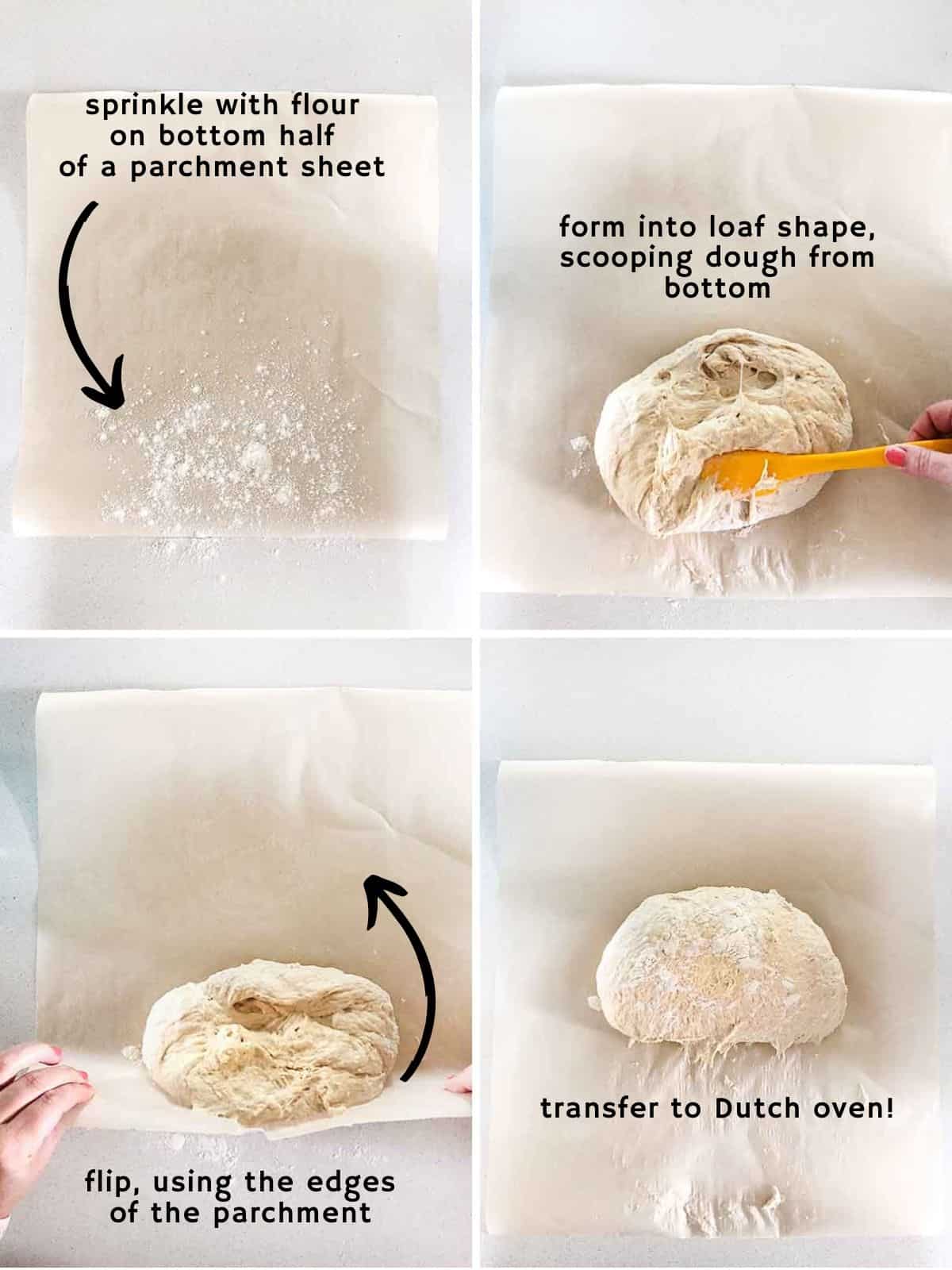
At this point, before putting it in the Dutch oven, you can use a very sharp knife or clean razor blade to make a few cuts about 1/2″ deep in the top of the loaf. I did this with mine in a cross shape from end to end in both directions. This will help it rise up a little more in the oven and get some browner crustier bits. But it’s totally optional.
Baking the bread
Once you have the loaf shape in the center of your parchment, open your oven door and take the lid off the Dutch oven (USING POTHOLDERS of course).
Then, grab the sides of the parchment paper and transfer the loaf to the Dutch oven. Place the cover BACK ON (USING POTHOLDERS FOR THE LOVE OF GOD), and bake at 450 degrees for about 35 minutes.
I know I keep yelling about potholders but too often I’ve reached absentmindedly for the lid of a Dutch oven thinking it’s going to be cool but it’s searing hot. It’s easy to make that mistake!
Once the 35 minutes are up, take the lid OFF, and bake for another 5-10 minutes, until it’s golden brown.
Stop for a moment, and inhale deeply. The smell of fresh-baked bread is one of the best things in the world.
Finally, remove the bread by holding the parchment paper, and place on a wire rack or a cutting board to cool. You want it to cool for at least 10 minutes before slicing.
AND YOU’RE DONE! Congrats on your gorgeous artisan Dutch oven bread!
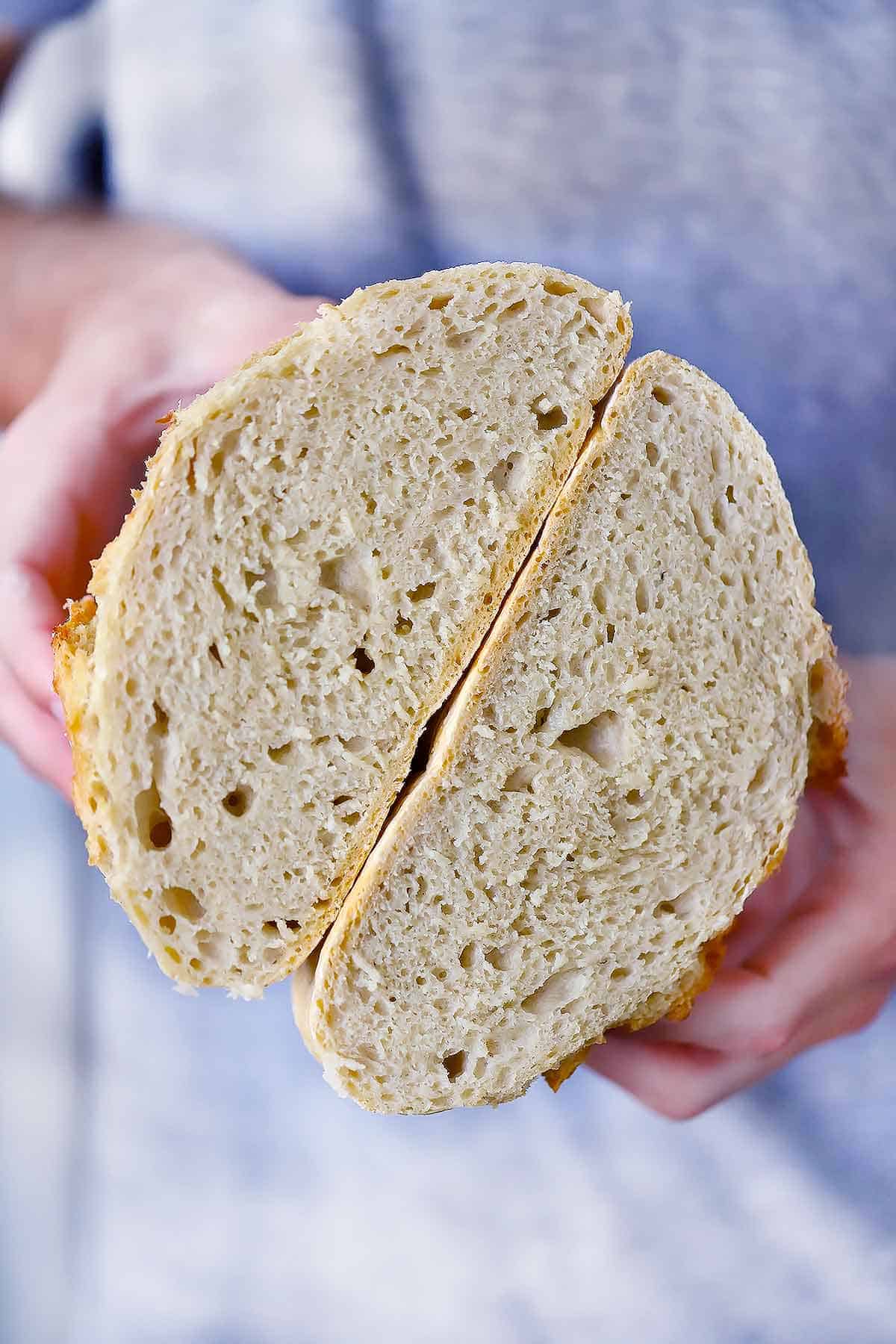
Why does the lid to the Dutch Oven need to be on while it bakes?
The key to moist bread with a perfectly crusty crust is that it needs to be baked in a humid environment. I know it seams counter-intuitive, but it really works.
The lid to the Dutch oven traps the steam from the sticky dough inside, making it a perfect bread baking environment.
Then, taking the lid off for the last bit of cooking helps really brown the top of the loaf without it over-drying.
It’s truly a miracle to behold. And it’s why we can call it “artisan bread!”
But what if I don’t have a Dutch Oven?
Glad you asked.
This bread is possible to make without a Dutch oven, but you won’t get the same amazingly crusty results. Don’t let that stop you- just temper your expectations a bit.
You can bake the bread, on parchment paper since the dough is so sticky, on a baking sheet or, preferably, in a preheated cast iron skillet.
Here’s what you can do to help make it extra tasty with a crusty crust.
Create a humid environment in your oven by placing a rimmed baking sheet on the bottom rack while the oven preheats. When you add the bread to the oven, pour about 4 cups of water onto the preheated baking sheet. This will create steam as the cold water hits the hot metal. Close the oven door as fast as you can to trap the steam inside.
Can I use another kind of flour?
I used all-purpose for this crusty artisan bread, but you can use bread flour if you like.
You can also use part whole wheat flour– I recommend substituting 1 cup of the AP flour with whole wheat. A 100% whole wheat loaf has not been tested, but it might work.
I haven’t tried using a gluten-free flour mix for this and therefore cannot recommend it. Here’s a gluten-free artisan bread that might be helpful for you!
And finally, you should never substitute a non-flour flour, such as almond flour or chickpea flour, for AP flour. Those won’t work with this bread.
Wait- don’t I need sugar to make bread?
Nope! Some people thing you MUST use sugar in bread or dough recipes so the yeast have something to eat. While yeast do love sugar, and adding sugar to dough can cause a more rapid rise time, it’s not necessary. Yeast love to eat flour too (which is a carbohydrate just like sugar, so acts in a similar way). So you don’t need sugar in this no knead bread recipe at all!
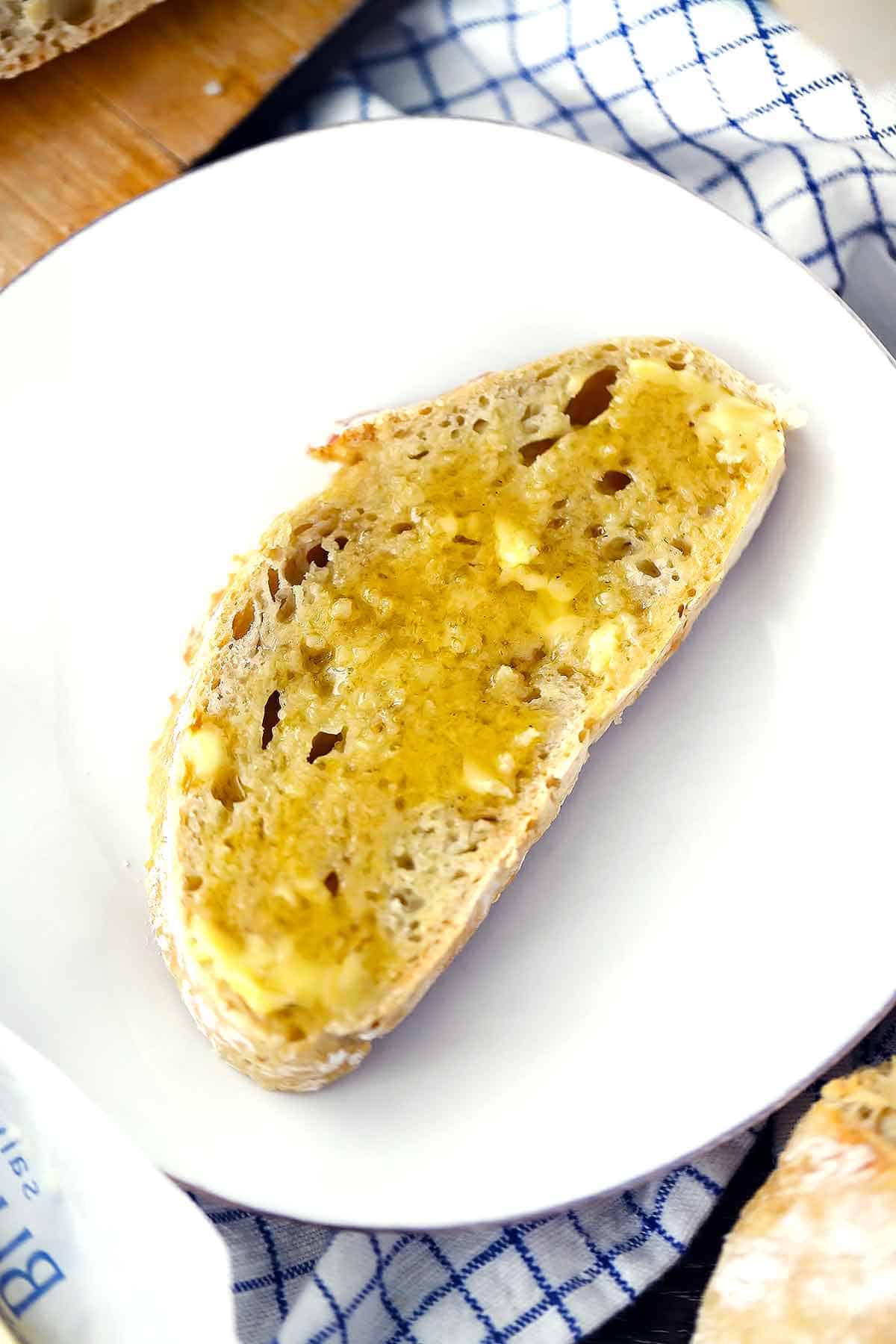
Can I freeze it?
Yes!
The bread stays good at room temperature in a plastic bag or airtight container for about 2 days, and it will get staler as time goes on. Any longer than 1-2 days, and you should freeze it.
You can freeze the loaf whole if you like- you’ll just need to leave it out for about 12 hours before you can slice into it.
Or, you can slice it before freezing, which enables you to take out one slice at a time for toast or sandwiches.
Here are some tips for freezing:
- Store the whole loaf or sliced loaf in an airtight bag, squeezing out as much air as possible. This will help prevent freezer burn.
- Wait until it’s COMPLETELY cool before storing, especially if you’re slicing it before, as the slices may stick together if you don’t.
It should stay good for 2-3 months in the freezer if stored properly.
Why didn’t my dough rise?
If your dough doesn’t rise, it is likely an issue with the yeast itself. Yeast is a living organism and needs to be able to eat food and multiply in order to cause a rise. As they multiply, they release gasses, which causes the airy pockets in the dough. Here are three reasons why your dough may not be rising:
- The yeast is dead to start out with. This can happen if the yeast is old, or sometimes even if you get a dud pack of it. A new pack of yeast from the store can sometimes make all the difference!
- The conditions don’t allow for the yeast to multiply. This usually happens if the temperature is too cold. At cooler temperatures, yeast may multiply much slower, or not at all.
- If the yeast is killed by accident. This can happen if the water temperature is too hot when added to the yeast, which can kill the yeast and subsequently cause no rise. (Note: it is a MYTH that salt kills yeast in this way! If you were to use tons of salt, it may kill the yeast, but the amount of salt used in this recipe won’t kill the yeast – at worst, it may just slow the multiplication process a little bit.
If your dough won’t rise, my advice is to start anew with brand new yeast and make sure to measure the temperature of your water with a thermometer – I love the Thermoworks Thermapen for a super fast, accurate read! Alternatively, you can stick your finger in the water and it should be about body temperature, so if it feels neutral or slightly warm you should be good!
How to serve an artisan bread loaf
I’m a big fan of eating the bread smeared with salted butter and drizzled with honey, as pictured above. But this homemade bread would be delicious…
- Served with a hearty soup, like split pea soup or lentil soup.
- Used for a fancy grilled cheese, like this leek and gruyere grilled cheese.
- To make cold sandwiches, like this fresh mozzarella, tomato, and basil sandwich with balsamic glaze.
- Served sliced with a basic olive oil and balsamic bread dip, as a side to your favorite Italian pasta recipe (like this five-ingredient pasta with Bolognese sauce).
- Used to sop up the sauce from classic shrimp scampi.
What to make with the stale bread
If you forget about the bread and leave it out at room temperature for more than a couple days, it may go stale. I hardly ever have this happen, as my family and I inhale the entire loaf in one sitting usually. But there are a few things you can do with the leftover stale bread!
Here are my favorites:
- Make homemade croutons with it
- Use it in Panzanella salad
- Make a Tuscan Tomato and Bread soup
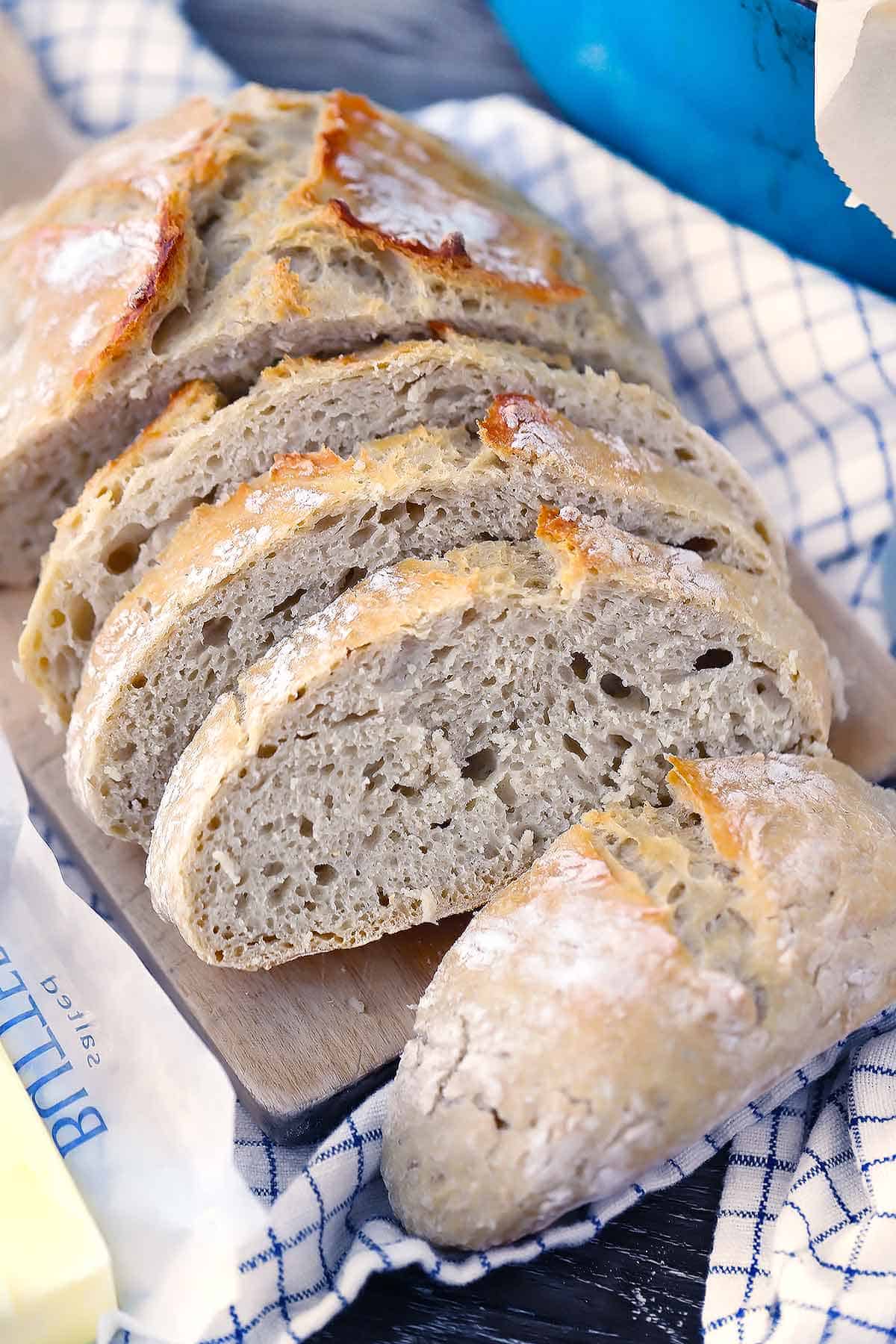
Do I HAVE to preheat the Dutch Oven?
No. I’ve made this plenty of times putting the loaf into a cold Dutch Oven and then baking for an extra 5-10 minutes with it covered. Preheating the Dutch Oven before baking the no knead bread can help get it a taller rise while baking, since it will start baking faster and more rapidly. But if you are concerned about preheating your Dutch Oven while it’s empty, as some manufacturers recommend not to do, or if you want it to just be a little easier/safer, feel free to skip this step!
How can I add other ingredients to the dough?
Once of the most common questions I get for this recipe is “Can I add herbs and cheese?” or “Can I add jalapenos and cheddar?” YES! It’s SO easy to add other ingredients to no knead bread.
Just add whatever other ingredients you want when you mix the dough together. Let it rise with all those ingredients, and then shape and bake as directed. You may even want to sprinkle the top with some extra ingredients. For example, sprinkle with grated parmesan or cheddar cheese, or brush with olive oil and sprinkle with rosemary and sea salt.
One thing to keep in mind: if you add ingredients with moisture, such as rehydrated dried fruit, olives, or pickled jalapeños, you will need to drain them very well and/or add less water to the mix. It’s not a huge deal, as this recipe doesn’t require a super exact ratio of liquid to flour, but keep in mind that extra moisture may affect outcome a little bit.
Here are some suggestions for no knead bread flavors:
- Jalapeño and Cheddar – add drained pickled jalapeños and grated or cubed cheddar cheese. Grated cheese will melt into the dough and flavor the whole thing, while cubed will maintain its shape and create melty pockets of cheese.
- Rosemary and Sea Salt – add chopped fresh rosemary to the dough, and before baking brush the top with olive oil and sprinkle with extra rosemary and a sprinkle of sea salt.
- Herb and Parmesan – add a medley of fresh or dried herbs to the dough, as well as grated parmesan. Sprinkle the top with extra herbs and parmesan after brushing with olive oil, if you want.
- Olive – add well-drained olives to the loaf. Whole or chopped, depending on how big you want them in the final thing. This is also great paired with the rosemary and sea salt or herb and parmesan combo above.
- Cinnamon raisin – let some raisins soak in warm water for a few minutes to plump up, drain well, and add them, along with some cinnamon, to the dough. You may want to add a little sugar to the dough as well here – this may cause a faster rise time, since yeast love sugar, so keep that in mind. Here’s a more detailed post on how to make cinnamon raisin no knead bread!
There are so many other ways to play around with other flavor combos- I’d love to hear about them in the comments!
Other easy yeast bread recipes
- Quick and Easy Dinner Rolls
- Vasilopita (Sweet Greek New Year’s Bread)
- Whole Wheat No-Knead Focaccia with Rosemary and Sea Salt
- Honey Whole Wheat Pizza Dough
- White Sandwich Bread (from The Brown Eyed Baker)
Check out all my homemade basic essential recipes here.
I also LOVE using my Dutch oven to roast a whole chicken.
Did you know commenting and rating recipes is one of the best ways you can support your favorite food bloggers? If you made this Dutch Oven No Knead Artisan Bread, please click the stars below to comment and Rate this Recipe
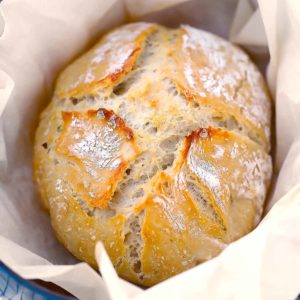
Dutch Oven No Knead Crusty Bread
Equipment
- Silicone Spatula
- Meat Thermometer for taking accurate temperature of the water
Ingredients
- 1 1/2 cups warm water (about 100 degrees F)
- 1 packet yeast (active dry, instant, or quick rise- 2.25 teaspoons)
- 1/2 tablespoon fine grain salt (preferably NOT iodized, see notes)
- 3 1/4 cups all-purpose flour or bread flour, more if needed to get correct consistency, plus more for dusting (I use King Arthur AP flour – other flours may yield different results)
Instructions
- In a large bowl (or container), mix together the warm water (1.5 cups), yeast (1 packet/2.25 teaspoons), and table salt (1/2 tablespoon), until yeast and salt are fully or almost dissolved (I like using a whisk for this).
- Add the flour (3.25 cups) to the bowl all at once and stir together until a sticky dough forms. Don't worry about mixing it too much, just make sure everything is uniformly wet. It WILL be messy and sticky. You can scrape what's left on the spoon with a silicone spatula. (photo below provided for what the texture should look like – if it seems too wet, add 1-2 tablespoons more flour at a time until it is more like the photo. If it seems too dry, do the same thing with more water).
- Cover the bowl with a kitchen towel (or place the container to the lid on ajar). Leave it for 2-3 hours to rise in a somewhat warm place until it's doubled in volume, like photo in previous step (If it's cold out, I like to preheat my oven for a few minutes, then turn it off, then place the bowl in the oven, trapping the heat inside. If your house is warm just leave it out, or if it's warm outside you can place it there).
- After the two-three hour rise time when the dough has about doubled, you have two options: bake, or store in the fridge. See notes for how to store.
- 30 minutes to an hour before you are ready to bake, preheat your oven to 450 degrees F. Place your Dutch oven in the oven, with the lid ON, while the oven is preheating. Once the oven reaches 450, keep it preheating for another 20 minutes, so the Dutch oven gets good and hot.
- Scrape the dough into the edge of a piece of parchment paper dusted with flour. Make it into as much of a "loaf" shape as you can by folding the edges up on top of it (a silicone spatula works well for this).
- Then, use the edges of the parchment paper to flip the loaf over so the floured side is on top and the loaf is in the center of the parchment paper. Don't worry about it looking beautiful or smooth on top. My Dutch oven is an oval, so I made an oval shape. You can do a circle if yours is round.
- Optional: use a very sharp knife or clean razor blade to cut a few slits across the top of the loaf about 1/2" deep, across the entire top. I did this in a cross shape for mine.
- Take out the preheated Dutch oven and take off the lid, carefully! Grab the parchment from the sides and place the loaf in your Dutch oven.
- Place the cover back on the Dutch oven and place in the preheated oven on the center rack. Bake for 35 minutes at 450 degrees F (40 minutes if dough was cold from the fridge). Remove the lid and bake for another 5-10 minutes, until a golden brown color forms- longer if necessary. Remove the loaf from the dutch oven (grabbing the sides of the parchment paper works well here) and place it on a wire rack or cutting board to cool for at least 10 minutes (preferably 30 minutes – an hour, if you have time) before slicing.
Notes
- Dough too wet/dry: some readers have commented that the dough is too wet. This can happen based on a few variables, including type/brand of flour and accurate measurements. See photo in post and recipe instructions – if texture doesn’t seem similar, add 1-2 more tablespoons flour or water as needed.
- Make two small loaves instead: You can make two smaller by using only half the dough at a time, saving some in the fridge for later. Once the dough has risen, you can take out half of it to divide it in half. Using a serrated knife to cut the dough in half directly in the bowl is a great way to do this, as it won’t deflate the dough as much. I recommend cutting the cooking time to 20-25 minutes covered if you do this. Alternatively, you can double the recipe to make two large or four small loaves, leaving the extra dough in your fridge for fresh bread every few days! Use a serrated knife to cut the dough into pieces, trying your best not to squish it down as you handle it, and make sure you use a very large container or bowl for this.
- Fine grain salt can be fine sea salt, Himalayan salt, or any other salt you prefer.
- Iodized salt is not recommended, but can be used if that’s all you have. The iodine in the salt may impart a bitter taste in the bread and it also may inhibit the growth of yeast, leading to a longer rise time.
- Kosher salt may be used instead of table salt- I recommend 2 teaspoons since it’s a larger grain. Same goes with coarse sea salt.
- Avoid “gummy” bread by allowing it to cool for a longer time. I often can’t resist and just tear into the thing after 10 minutes, but often the inside seems gummy, and almost raw, because it’s too steamy to cut into. Waiting a whole hour, if you can manage, is ideal.
- Super hard, tough bottom crust? Next time, try putting a baking sheet on the bottom rack of the oven. It will help divert some of that high heat away from the bottom of the Dutch Oven as it bakes.
- Some Dutch Oven manufacturers recommend NOT preheating an enameled cast iron Dutch Oven empty. It may result in the enamel cracking. I’ve never had a problem with my Lodge Dutch Oven, but if you’re nervous about it, you don’t have to preheat the Dutch Oven. Just put the dough in the cold Dutch Oven and bake for 5-10 minutes longer covered, and you should be good to go!
- How to store dough in fridge: If storing in the fridge, leave the lid ajar or use loose plastic wrap covering the bowl so gasses can escape. Storing it in the fridge makes the sticky dough a bit easier to handle, and it also enhances the flavor, so I recommend refrigerating it for at least 12 hours. It can stay in the fridge for up to 7 days! After two days, you can seal the lid to the container or cover the bowl tightly with plastic wrap. The taste of the bread will get funkier the longer it stays in your fridge. By the 7th day, it will taste more like sourdough.
- Since cold dough is easier to handle, you can place the dough in the fridge for 30 minutes or so after the two hour rise time, just before baking, so it’s easier to scrape out and form.
- If using cold dough from the fridge, I recommend baking for 5-10 minutes longer with the lid on (40-45 minutes instead of 35 minutes).
- Dutch Oven Alternatives: The Dutch oven does a really good job of trapping the steam, ensuring a crusty, golden brown loaf. If you don’t have a dutch oven, you can bake this bread on a baking sheet or in a cast iron skillet. I recommend adding some water to a rimmed baking sheet, or other oven-safe dish, and placing it in the oven on the lower rack, to add steam to the oven and help develop a crusty crust.
- Freeze the baked bread by slicing it first, then storing it in a zip-top bag, squeezing out as much air as possible. The bread should be completely cool before freezing. You can also freeze a whole or half loaf without slicing, wrapped tightly in plastic wrap, but you’ll need to wait to defrost the whole thing before slicing into it.
- Dutch Oven Size: I use my oval 5.5 qt. Dutch Oven or my 6 qt. round Dutch Oven for this recipe. There is some wiggle room, so you can go a little smaller if you like, especially if the parchment paper comes up the sides to prevent sticking. And you can definitely go bigger if you want.
- Parchment paper trick: crumple up the parchment before using it, to help it mold to the shape of the Dutch oven better.
- Sticking to the parchment paper: A few readers have noted that their bread sticks to the parchment after baking. This usually does NOT happen, as parchment paper is non-stick. However, after doing some research, I found that sometimes using a very cheap brand of parchment paper can result in the bread sticking. I recommend using a “nicer” brand of parchment paper, or brushing or spraying it with a little bit of oil or nonstick spray before placing the shaped loaf on the paper and baking it.
- Parchment paper at high temperatures: Some readers have expressed concern over the high temperature used for parchment paper. I’ve used parchment rated to 420 degrees for this recipe with no issue, but you can buy a parchment paper rated to 450 degrees if you are concerned. Here’s a great article about using parchment paper at high temperatures. As a general rule, keep an eye on what you are cooking, for any recipe!
- Avoid too much flour on the outside of the bread: You can use a pastry brush to brush away any thick layers of flour – before baking is best but after works too! You can also spritz the outside of the loaf with some water from a spray bottle, which also can add some lovely blisters to the crust.
- For a hard, too crusty bottom of the loaf: try putting a baking sheet on the bottom rack of the oven while baking. It helps deflect some of that direct intense heat away from the bottom of the Dutch Oven, resulting in a softer bottom to the loaf.
- Dry dough? Some readers have commented that their dough is dry, not wet and sticky. If this happens, it may have something to do with the brand or type of flour, or measuring discrepancies. Jut add a little more water until it’s a little looser and you should be good to go!
- High Altitude? A reader did this at a high altitude and she said she just added a little more water to the dough (about 1 tablespoon) and kept the towel damp during the rise time.
- Adding other ingredients: Feel free to mix in other ingredients, like herbs, roasted garlic, parmesan cheese, etc. with the rest of the ingredients! Then let it rise, shape, and bake according to instructions. See more about this in the body of the post with flavor suggestions.
Nutrition
Nutrition Information Disclaimer
The provided nutrition information is my best estimate and does not include any added sodium from seasoning to taste, any optional ingredients, and it does not take brands into account. I use an automatic API to calculate this information. Feel free to calculate it yourself using one of these tools:



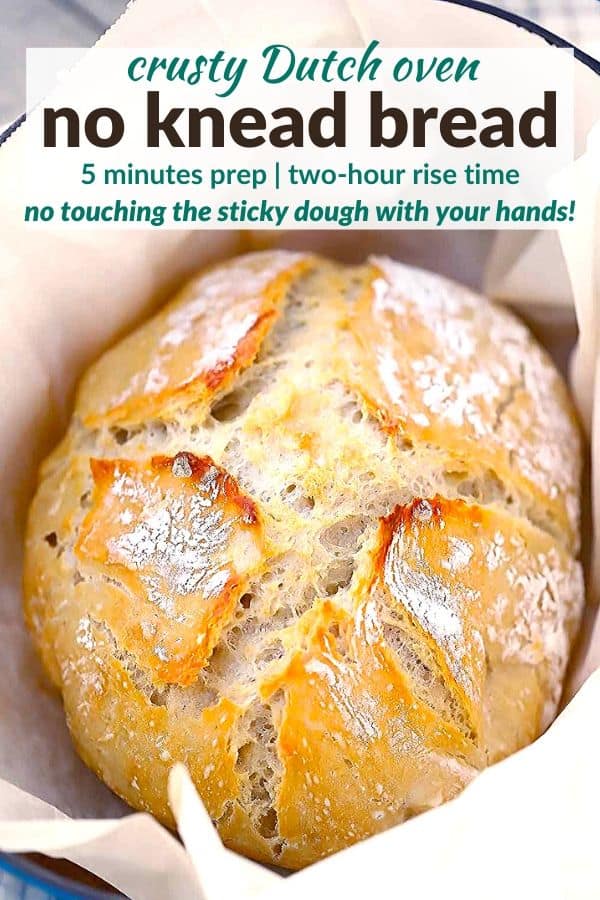
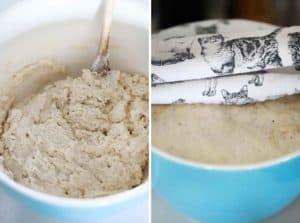
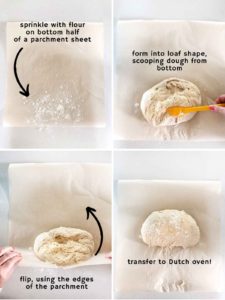
M Kay
I was gifted a Lodge Dutch Oven and tried this recipe for the first time. My bread came out incredible! Crispy on the outside and soft on the inside with lots of pockets. After reading the comments I didn’t want to work it too much after flipping it to the middle of the parchment paper so it wasn’t perfectly round which is ok with me!
I also took the suggestion of brushing with OO and salt after taking the cover off. I wish I had rosemary! Well; thank you and I will look forward to making this again!
M Kay
I forgot to say that I used King Arthur Bread Flour.
Elizabeth Lindemann
So glad you liked it!
Amanda S.
This was my first time using this recipe and making bread in a Dutch oven. I followed the recipe to a T but my dough came out dry and clumpy so I added a little bit of water and then flour and the dough looked better. User error, not your fault. My bread came out GORGEOUS and the taste is soooo good! Although it didn’t come out as airy as yours did, it is still really good. I’m definitely going to give this another try since its easy to follow. Thank you for the recipe!
Elizabeth Lindemann
So glad you liked it! Good job adjusting on the fly and adding more water! 👏
cupcake
trying your recipe today. i also was gifted a dutch oven this past christmas and love fresh bread. i’m going to let it proof overnight. i was wondering if adding protein powder would affect the baking and rising of the dough.
Elizabeth Lindemann
That’s such an interesting question! I’ve never added protein powder to a bread recipe before. You’d want to pay attention to the moisture content of the dough – my guess is that it will want to absorb a lot of liquid so you may need more water in the dough. For experimenting, I’d start with adding just a little bit the first time you make it and see if you can add more the next time.
One other thought – you may want to add some vital wheat gluten to the mix. This is exactly what it means – it’s gluten, which can really help a dough be strong and get those nice airy pockets. And it’s the protein part of flour! It has 7 grams of protein per tablespoon. I wouldn’t add more than a tablespoon or two to this recipe, but it could help get that protein content up while also enhancing the structure of the dough. If you try either of these options I’d love to know how it turns out for you!
Gina
I had good intentions of following the recipe and protocol, but somehow I managed to deviate from the recipe. I was so scared that I would end up with a heavy, dense loaf but by the grace of God it came out beautifully! I felt like I overhandled the bread upon taking it out after the first rise, so I did some googling and thought I’d just keep over handling it, knead it a bit, and give it a second rise. It actually all worked! If you have any insight on this, please let me know. I’ve heard of second rises but I wasn’t sure if it would work out or not. Glad it did!
Elizabeth Lindemann
Oh wonderful, so glad you were able to troubleshoot this! That second rise probably worked because the yeast still had some multiplying to do. If you try and do a second rise and the yeast is spent, it won’t work. A second rise will also mean many of the large air pockets are pushed out, which can result in a fluffy bread result but fewer large holes. And it’s more work (which is the point of a no knead bread haha!). I’m so glad you mentioned this here as a way to adjust if you feel like the bread was handled too much when shaping! Good job 👏
Sheila Waters
Thank you for this amazing recipe. I live in China and the local bread is not made for a western palate. So having this bread really warmed my heart and my whole family devoured it in minutes.
Elizabeth Lindemann
So glad you liked it!
Penni
I have made this wonderful recipe many times but have not left in the fridge to “mature” to sourdough-like taste. Do I bring the cold dough up to room temperature before baking right out of the fridge or does it need to proof again for a couple of hours?
Elizabeth Lindemann
You can just use it cold! It’s actually much easier to handle when cold. This is assuming it’s already risen at room temperature, THEN was refrigerated.
MrsZ
I’ve used this a dozen time now and we love it. My college kid is learning it today to make for her and her roommates at their apartment – so now I need to buy her a dutch oven. I ‘ve tweaked a bit for my environment – my house is always cold – preheat in a warm oven, I let the yeast water sit 20 minutes or so before adding the flour, I also put a shallow pan full of water in the oven while baking. It would be great for some guidance on adding to this loaf – I was thinking roasted garlic and asiago maybe? Thank you!
Elizabeth Lindemann
So glad you liked it! Roasted garlic and asiago sounds amazing. Just add any add-ins with all the other ingredients, mix, and let rise! I’m planning on working on a few versions of this recipe with add ons, stay tuned over the next few weeks :-)
Claire
Hi! I’m super excited to try this recipe, I got a Dutch oven for Christmas🥳 Quick question, does storing the dough in the fridge overnight make it smell like alcohol?😂 I made a naan bread once, stored the dough in the fridge overnight and the next morning it smelled so heavily of wine that I didn’t want to use it lol. I guess the yeast just fermented? Either way, weird question, but wanted to ask!
Elizabeth Lindemann
I love this question! This happens with my sourdough starter. I think if you kept this recipe in your fridge for a few days, it might start to smell more fermented. It’s not the yeast, I believe it’s actually the bacteria that does this. My guess for the naan was that it had yogurt in it? If so, it’s possible it smelled a little funky from that, since yogurt has all that good bacteria and is fermented itself, and the bacteria may have multiplied more with the rise time. Hope that helps!
Becky
Beautiful bread on my first attempt!! Thank you so much for the – obviously – fool-proof recipe ;) I’m so pleased to have found your site. I’ll be trying the butterscotch pudding recipe next. Thanks for developing such a simple recipe for those of us still learning the art of baking bread.
Elizabeth Lindemann
So glad you liked it! Hope you enjoy the butterscotch pudding!
Audrey
I thought the process was very easy and the step by step directions made this fun to try! Unfortunately I experimented with only whole wheat flour (instead of just subbing half) and my final product was very dense. Just wanted to share here in case others were going to attempt that! Next time I’ll try using half all-purpose flour!
Elizabeth Lindemann
So glad you liked it! Yes, 100% whole wheat will result in a very dense bread and is very tricky to work with because of its heaviness and lack of gluten. You may want to try half and half, and also consider adding a tablespoon or so of vital wheat gluten to the mix!
Rob Iam
I have a 4.5 quart Dutch over. Any tips for how to adjust for this size? Can I still use the same recipe?
Elizabeth Lindemann
I think you can use the recipe still! Should be fine.
Jenny
Such a great, easy recipe! Definitely a keeper!
Elizabeth Lindemann
So glad you liked it!
Tara
Loved! Mine turned out wonderful. First time making bread in my Dutch oven and was pleased to come across a recipe that had such wonderful notes and tips. I will say maybe add in (DON’T TOUCH THE LID WITHOUT AN OVEN MIT) a few more times haha. I touched it despite the many warnings. Cracked up after reading the many that you included. Thank you again for a great recipe.
Elizabeth Lindemann
So glad you liked it! Oh man, haha, I STILL make that mistake despite putting in these ALL CAPS WARNINGS myself, lol!
Shari
Just made this, and it turned out pretty well. I’ve never made bread before, so this was a perfect intro recipe.
For next time, I’d like to make the bread slightly airier and add a bit more flavor. Any recommendations?
Elizabeth Lindemann
So glad you liked it! To make the bread airier, you can try developing more gluten. Try mixing the dough for longer in the beginning – a standing mixer makes easy work of this. And keep practicing forming the loaf without too much handling, sometimes an airy bread just takes practice! Hope that helps!
Jenny
1st attempt at making bread, this was perfect! I skipped the parchment paper and the crust was perfect, no sticking
Elizabeth Lindemann
So glad you liked it!
Arp
I’ve made several loaves using this recipe and it’s a keeper! So easy and very easily adapted to high altitude baking. I dropped the temp to 425 and added about an eighth of a cup more water. Came out perfect! Thanks you for sharing.
Elizabeth Lindemann
So glad you liked it! Thanks for sharing your adjustments for high altitude!
Nicole
I’ve never made bread before until now! I was gifted a Dutch Oven for Christmas, found your easy recipe, followed it exactly, and TA-DA…BREAD!! My kids and I enjoyed it very much!! Thank you!
Elizabeth Lindemann
So glad you and your kiddos liked it!
Maria
Made this today and it was incredible! It was my first ever time making any kind of bread and it was a big hit in my house. Will definitely be making this again.
Elizabeth Lindemann
So glad you liked it!
Susan Rago
Can you provide the weight for each ingredient? I will be using King Arthur AP.
Thanks,
Sue
Elizabeth Lindemann
If you click on the link on the recipe card that says “Metric” under the ingredients list, it will give you the weights! Hope that helps!
Jane Rossetti
Never again. Wasted all the ingredients plus my time. First time I used your website. Not sure I’ll ever try it again
Elizabeth Lindemann
I always think it’s a bit interesting – and bold – to get these few comments that blame me, my website, or the recipe itself for a poor outcome, amidst hundreds of specific glowing, successful reviews. It takes chutzpah to proclaim that this recipe is horrible when hundreds of others would disagree with you, and the photos of the recipe show a good outcome! Bravo for your bravery.
It’s always is tough to have a recipe not come out the way you want, so I understand that you’re frustrated. My suggestion is this: bread baking can be finicky, and a poor outcome can be based on many different factors including user error. You can always try again! If you let me know more details as to what exactly went wrong I’m always happy to troubleshoot if you want to give it another shot. Hope you have a great day!
katie smitham
what’s the best way to store the baked bread? it’s delicious!!
Elizabeth Lindemann
On the day it’s baked, I like storing it cut-side down on a cutting board, which will keep the crust crusty and the inside soft. After that, I usually slice it and then freeze it, which helps keep it from drying out. Then I take out a slice at a time to use when I want it!
SANDRA
This may sound flaky but I always find creating anything without love and the resulting poor vibrations that state of mind radiates has the power to cause a poor outcome. Try again and think happy thoughts or happy memories that fill you with joy. This could be the one ingredient that you forgot to include in your efforts, you will like what happens. Though you cant see love or joy it is very real and positive part of any creation. Now go girl and put a little love in there this time
Elizabeth Lindemann
Absolutely love this perspective! Thanks for sharing ❤️
Lynn
I’m proofing the bread right now but I just wanted to say BRAVO to your response to poor ole Jane who must be so mad that she can’t make bread. You k own what they say: If at first you don’t succeed, try try again!
I’ll let you know how MY attempt turns out!
Lynn
My dough was super wet after oven proofing for 3 hours so I think the temp may have been too high. I added more flour and it was fantastic! The crust was amazing
Elizabeth Lindemann
So glad you liked it!
Elizabeth Lindemann
Thanks for saying that!
Katie
This recipe is great! My bread turned out delicious.
Elizabeth Lindemann
So glad you liked it!
Janet
I made this for the first time today with a pot of Red Lentil Soup. It was absolutely delicious. Will definitely make again and so easy.
Elizabeth Lindemann
So glad you liked it!